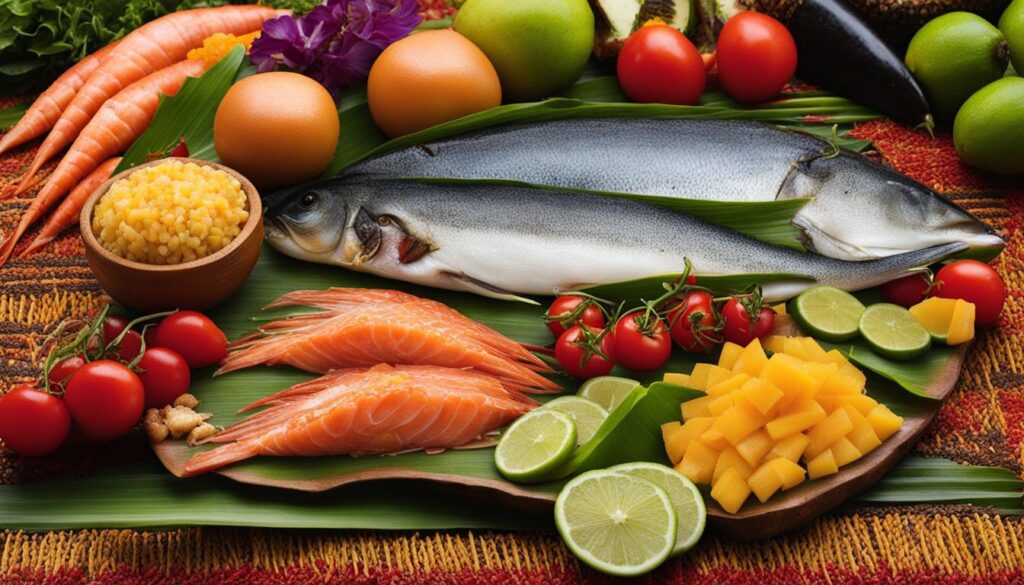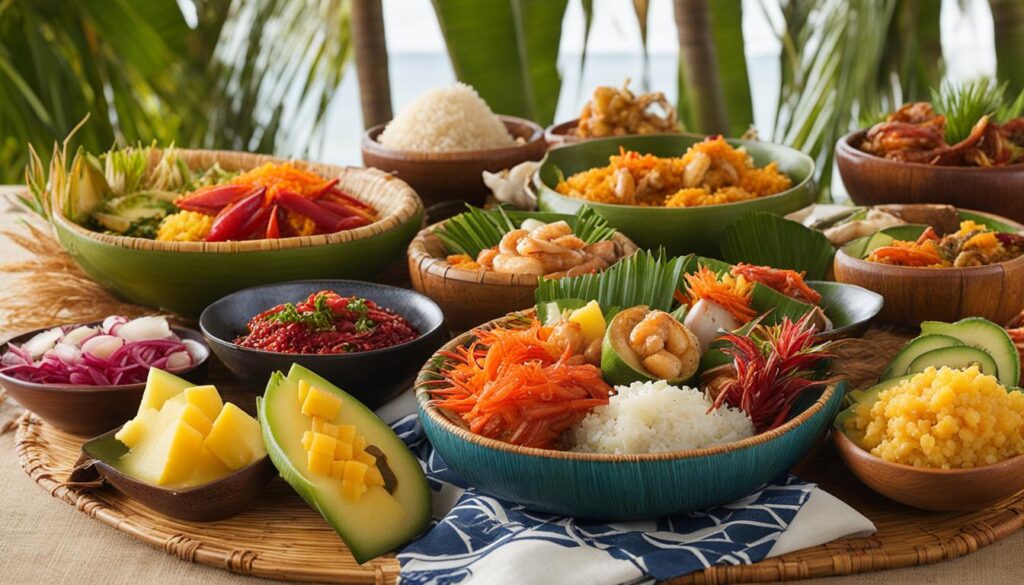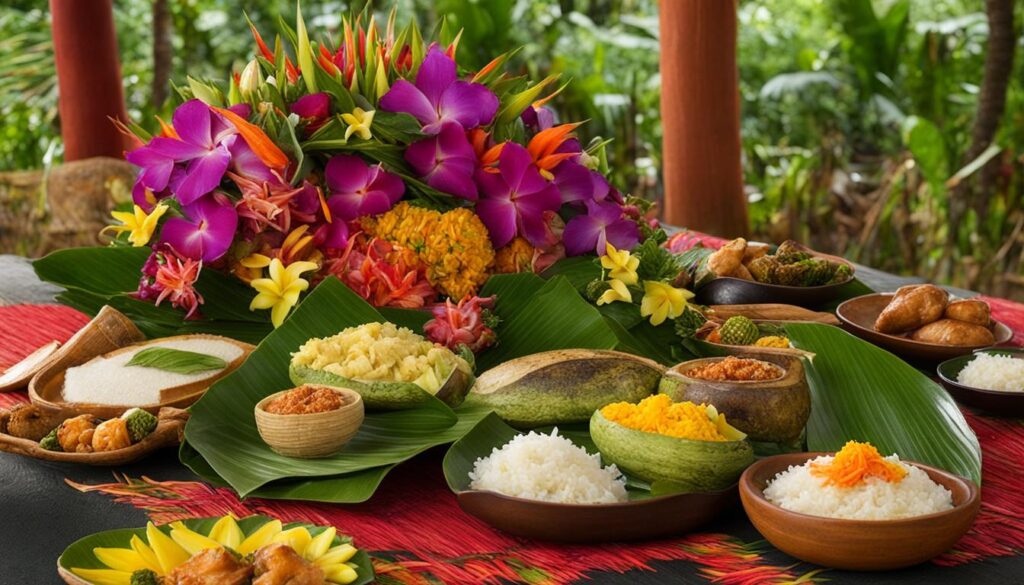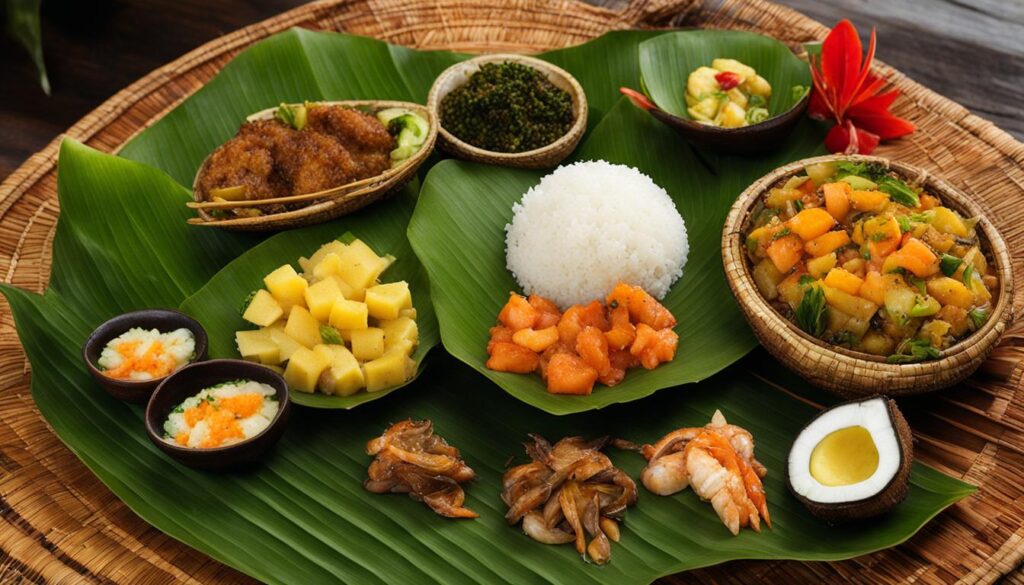Samoa, like many other island nations in Oceania, is currently experiencing a health crisis related to dietary habits. Conditions such as type 2 diabetes, hypertension, and obesity are prevalent in Samoa and are linked to changes in the traditional Samoan diet. This section will delve into the history of food in Samoa and explore the role of food in Samoan culture.
Key Takeaways:
- The traditional Samoan diet is deeply rooted in Samoan culture and consists of foods such as baked taro, breadfruit, yams, and locally caught fish.
- Imported processed foods have become increasingly popular in Samoa, leading to concerns about the impact on Samoan health and the preservation of traditional cuisine.
- Food plays a central role in Samoan culture, symbolizing care, respect, and love within families and communities.
- The modernization of the Samoan diet presents challenges in terms of taste preferences, cultural practices, and the availability of traditional ingredients.
- The changes in the Samoan diet have had significant health implications, contributing to the rise in dietary-related diseases.
The Importance of Traditional Samoan Foods
Traditional Samoan foods hold a significant place in the culture and heritage of Samoa. These unique dishes are not just a source of sustenance, but they also represent a deep connection to the land, history, and traditions of the Samoan people. From baked taro to freshly caught fish, traditional foods encapsulate the essence of Samoan identity.
These traditional foods are not only delicious but also symbolize important values within Samoan society. For example, sharing a meal prepared with love and care is a way of showing respect and hospitality to guests. Traditional Samoan foods are often enjoyed during special occasions such as weddings, funerals, and religious ceremonies, further emphasizing their significance.
Furthermore, traditional Samoan foods are considered a national treasure. They represent the rich cultural heritage of the Samoan people and serve as a reminder of the significance of locally sourced ingredients. By embracing and promoting these traditional foods, Samoa can preserve its unique culinary traditions and ensure their continuation for future generations.

The Role of Traditional Foods in Samoan Culture
Traditional Samoan foods play a vital role in Samoan culture, not only as a means of nourishment but also as a means of fostering community and strengthening social bonds. The act of preparing and sharing traditional meals brings families and communities together, promoting a sense of unity and belonging.
| Traditional Samoan Foods | Significance |
|---|---|
| Baked Taro | A staple food that represents strength and sustenance. |
| Breadfruit | A versatile fruit that symbolizes abundance and prosperity. |
| Locally Caught Fish | Exemplifies the connection between the Samoan people and the ocean, highlighting their reliance on natural resources. |
| Fa’apapa | A coconut-based flatbread that represents the importance of the coconut tree in Samoan culture. |
“Traditional Samoan foods are a reflection of our identity, heritage, and connection to the land and sea. They are not just meals, but a way of honoring our ancestors and preserving our culture for future generations.” – Samoan Elder
By embracing and celebrating traditional Samoan foods, the Samoan people can maintain their cultural identity, promote healthy eating habits, and contribute to the overall well-being of the community.
The Modern Dietary Landscape of Samoa: Changes and Challenges
In recent years, the cuisine of Samoa has experienced significant transformations, reflecting the impact of globalization and the introduction of imported processed foods. While traditional Samoan foods continue to hold cultural importance, the consumption of these imported foods has become increasingly prevalent, raising concerns about the preservation of Samoan cuisine and the health implications for the population. The evolving dietary landscape in Samoa presents a complex challenge that requires a careful balance between tradition and addressing health concerns.
The introduction of imported processed foods has led to a shift in dietary habits in Samoa. Foods such as hot dogs, instant ramen, and canned corned beef have become staples in the daily diets of many Samoans, often accompanied by sugary drinks. These changes in dietary patterns have raised concerns about the impact on Samoan health, contributing to the rise of conditions like obesity, type 2 diabetes, and hypertension. It is essential to understand the cultural significance of Samoan cuisine and the challenges associated with promoting healthier eating habits.
Despite the growing presence of imported foods, traditional Samoan cuisine remains an integral part of the country’s culture. Festive foods in Samoa, such as baked taro, breadfruit, yams, and locally caught fish, continue to be cherished and consumed during important ceremonies and celebrations. These traditional foods not only provide nourishment but also convey values of respect, love, and wealth within Samoan communities. However, the increasing availability and affordability of imported processed foods have led to a shift in dietary preferences, raising questions about the future of traditional cuisine in Samoa.
| Dietary Changes in Samoa | Impact on Health | Preservation of Tradition |
|---|---|---|
| The introduction of imported processed foods | Rise in dietary-related diseases such as obesity, type 2 diabetes, and hypertension | Challenges in balancing cultural practices and promoting healthier eating habits |
| Consumption of foods like hot dogs, instant ramen, and canned corned beef | Increased health risks and strain on the healthcare system in Samoa | Continued importance of traditional Samoan cuisine in ceremonies and celebrations |
The modern dietary landscape in Samoa presents a complex challenge that requires careful consideration. It is crucial to raise awareness about the health implications of imported processed foods while respecting and preserving the cultural value of traditional cuisine. Finding a balance between tradition and addressing health concerns is essential for promoting a healthier future for Samoans and ensuring the longevity of traditional Samoan cuisine.

The Role of Food in Samoan Culture
Food holds great significance in Samoan culture, representing care, respect, and love within families and communities. Sharing a meal is seen as a bonding experience, fostering unity and reinforcing social connections. Samoans take pride in their ability to provide abundant meals for their guests, as it is considered a sign of hospitality and social standing.
In Samoan culture, large feasts are a common feature of ceremonies and celebrations. These events, known as “fiafia,” bring people together to celebrate milestones such as birthdays, weddings, and the successful completion of important tasks. During these feasts, a wide variety of traditional dishes are served, showcasing the rich culinary heritage of Samoa.
Traditional Samoan foods, such as palusami (meat or fish wrapped in taro leaves and cooked in coconut cream), sapasui (Samoan-style chop suey), and lu’au (young taro leaves cooked in coconut cream), are popular choices for these festive occasions. These famous foods of Samoa are carefully prepared with love and skill, often passed down through generations. They bring joy and satisfaction to those who consume them, as they represent the essence of Samoan identity and cultural pride.

The Significance of Food Gifts and Exchanges
In addition to feasts, food gifts and exchanges play an important role in Samoan culture. When visiting someone’s home, it is customary to bring a gift, often in the form of cooked or prepared food. This gesture symbolizes respect and gratitude for the host’s hospitality.
“Food gifts are a tangible expression of love and appreciation in Samoan culture. They strengthen relationships and create a sense of unity within communities.” – Dr. Leilua Ioane
Food exchanges also occur on a larger scale between villages. When one village hosts a significant event, such as a traditional dance performance or a political gathering, other villages may send food as a tribute. These exchanges not only serve as a demonstration of support but also foster goodwill and strengthen connections between communities.
| Famous Samoan Foods | Description |
|---|---|
| Palusami | A traditional dish made with meat or fish wrapped in taro leaves and cooked in coconut cream. It is a crowd favorite during special occasions. |
| Sapasui | Samoan-style chop suey made with noodles, vegetables, and a rich tomato-based sauce. It is often served at gatherings and celebrations. |
| Lu’au | Young taro leaves cooked in coconut cream, often paired with meat or fish. It is a staple dish that represents the essence of Samoan cuisine. |
Challenges of Modernizing the Samoan Diet
The modernization of the Samoan diet presents numerous challenges, as the consumption of imported processed foods has become deeply ingrained in the culture. While there is a desire to return to traditional Samoan foods as a solution to the health crisis, eliminating these modern food choices entirely would require significant changes in taste preferences, cultural practices, and the availability of traditional ingredients.
The shift towards imported processed foods in Samoa has been driven by factors such as convenience, affordability, and cultural significance. These foods are often seen as tasty and have become a symbol of social and economic status. They are widely available and have become a part of daily eating habits, making them difficult to replace completely.
In order to encourage a return to traditional Samoan foods, it will be important to address the perceived barriers to their consumption. This includes educating the population about the health benefits of these foods, promoting traditional cooking techniques and recipes, and ensuring the availability and affordability of traditional ingredients. Additionally, efforts should be made to create a cultural shift that celebrates the value and importance of traditional Samoan foods in the context of health and well-being.
| Challenges | Possible Solutions |
|---|---|
| Taste preferences for processed foods | Education and promotion of traditional food flavors and cooking techniques |
| Affordability and availability of traditional ingredients | Support for local agriculture and traditional food production, subsidies for traditional ingredients |
| Convenience and cultural significance of imported foods | Creating a cultural shift that revalues traditional Samoan foods and their role in health and well-being |
Historical Overview of Samoan Food Culture
The history of Samoan food culture dates back to the arrival of the Lapita people around 3,500 years ago. These early settlers brought with them domesticated animals and cultivated crops such as coconut, taro, and breadfruit, which continue to be integral to Samoan cuisine today. The Samoan way of life, governed by chiefs and matai, played a crucial role in regulating food production, procurement, and consumption.
During this time, traditional food preparation techniques were developed, including the use of an earth oven, known as an umu. The umu involves heating stones in a pit, placing wrapped food on top of the stones, and covering it with banana leaves. The food is then slow-cooked, resulting in flavorful and tender dishes.
The traditional Samoan diet consisted of a variety of indigenous ingredients, including root crops, fish, and coconuts. These foods provided essential nutrients and sustained the Samoan people for generations. The cultural significance of food in Samoa cannot be overstated, as it symbolizes care, respect, and love within families and communities.

Table: Traditional Samoan Ingredients
| Root Crops | Proteins | Fruits |
|---|---|---|
| Taro | Fish | Bananas |
| Breadfruit | Coconut | Pineapples |
| Yams | Pork | Papayas |
Table: Traditional Samoan Dishes
| Breakfast | Lunch | Dinner |
|---|---|---|
| Pani popo (sweet coconut buns) | Oka (raw fish salad) | Palusami (taro leaves cooked in coconut cream) |
| Fa’ausi (sweet coconut porridge) | Taro and fish soup | Luau (taro leaves and corned beef in coconut milk) |
Through generations of Samoan food culture, these traditional ingredients and dishes have shaped the national culinary identity of Samoa. While modernization and the availability of imported foods have brought changes to the Samoan diet, the traditional foods of Samoa continue to hold immense cultural value and remain an essential part of Samoan life.
Evolution of Samoan Food Availability
Over time, the availability of food in Samoa has undergone significant changes, impacting the traditional Samoan diet. While locally grown foods such as coconut products, fruit, and starchy root crops have shown minimal increase, the availability of imported foods has risen substantially. This shift in food availability has influenced the national food culture of Samoa, raising concerns about the preservation of traditional cuisine and its impact on the health of the population.
To better understand the evolution of food availability in Samoa, let’s take a closer look at the current landscape. The most consumed local foods in Samoa continue to be coconut, taro, breadfruit, and fish. These traditional foods are still central to the Samoan diet and play an integral role in cultural practices.
However, the introduction of global trade and the reliance on imported foods have led to the increased availability and consumption of poultry meat and vegetable oils in Samoa. These imported foods have become more accessible and affordable, attracting Samoans with their convenience and taste. As a result, they have gradually become part of the national food culture, challenging the traditional Samoan cuisine.
| Locally Grown Foods | Imported Foods |
|---|---|
| Coconut products | Poultry meat |
| Fruit | Vegetable oils |
| Starchy root crops | – |
“The availability of imported foods in Samoa has increased significantly, challenging the traditional Samoan diet and its cultural significance.” – Samoan Food Research Institute
While the increased availability of imported foods may provide more choices for Samoans, it also raises concerns about the health implications. Processed foods are often high in calories, unhealthy fats, and added sugars, contributing to the rise of obesity, type 2 diabetes, and other diet-related diseases in Samoa. The impact of these health conditions not only puts a strain on the healthcare system but also raises questions about the long-term health and well-being of the Samoan population.
As Samoa continues to navigate the challenges of modernization and globalization, finding a balance between preserving traditional food culture and promoting healthier dietary choices remains a crucial task. It requires a holistic approach that considers cultural traditions, taste preferences, and economic factors while addressing the pressing health concerns. By prioritizing the preservation of traditional Samoan foods while encouraging the consumption of nutritious options, Samoa can work towards improving the health and well-being of its people.

Impact of Diet on Health in Samoa
The changes in the Samoan diet have had a significant impact on the health of the population. The introduction of imported processed foods has led to an increase in dietary-related diseases such as obesity, type 2 diabetes, and hypertension. These diseases have put a strain on the healthcare system in Samoa and have raised concerns about the long-term health of the population.
According to recent studies, the rise in obesity rates in Samoa can be attributed to the increased consumption of calorie-dense, processed foods. These foods are often high in sugar, unhealthy fats, and sodium, contributing to weight gain and the development of chronic diseases. The adoption of a more sedentary lifestyle, with less physical activity and increased screen time, has further exacerbated the health issues associated with the modern Samoan diet.
The impact of diet on health in Samoa is a pressing issue that needs to be addressed. The government and healthcare organizations are implementing various strategies to promote healthier eating habits and prevent the onset of chronic diseases. These strategies include educational campaigns, community outreach programs, and the promotion of traditional Samoan foods and cooking methods. By encouraging the consumption of nutritious, locally sourced foods and promoting physical activity, efforts are being made to improve the health outcomes of Samoans.
Key Points:
- The introduction of processed foods has led to an increase in dietary-related diseases in Samoa, such as obesity, type 2 diabetes, and hypertension.
- The modern Samoan diet, high in calorie-dense foods, unhealthy fats, and sugar, contributes to weight gain and chronic diseases.
- Lifestyle factors, including a sedentary lifestyle and increased screen time, further exacerbate the health issues associated with the modern Samoan diet.
- Efforts are being made to address the impact of diet on health in Samoa, including educational campaigns and the promotion of traditional Samoan foods.

Factors Influencing Food Choices in Samoa
In Samoa, a variety of factors influence food choices, shaping the dietary habits of its people. These factors encompass cultural traditions, ingredient availability, taste preferences, and economic considerations. The delicate balance between preserving cultural identity and embracing convenience and affordability poses a complex challenge for individuals and communities in Samoa.
Traditional Practices and Cultural Significance
Samoa takes immense pride in its traditional food practices, which hold great cultural significance. The preparation and consumption of traditional Samoan dishes are often connected to celebrations, ceremonies, and family gatherings. The preservation of these practices is a way of honouring heritage and maintaining a sense of cultural identity. However, the increasing influence of imported processed foods poses a threat to the continuation of these culinary traditions.
Moreover, the desire to showcase wealth and generosity through food is deeply ingrained in Samoan culture. Lavish feasts, known as “fiafia,” are organized to demonstrate hospitality, respect, and love for guests. The tradition of sharing abundant meals symbolizes social standing and reinforces bonds within families and communities.
Taste Preferences and Availability
While traditional Samoan dishes remain cherished, the introduction of imported processed foods has altered taste preferences. The accessibility and affordability of these foods have made them desirable options for many. The convenience of instant meals, such as packaged ramen noodles, can be enticing, particularly for those with busy lifestyles.
Imported foods also provide options that are not readily available through local produce alone. The availability of ingredients like chicken and vegetable oils has increased substantially, diversifying the range of recipes and dishes that Samoans can create. However, this diversity also contributes to the challenge of balancing the preservation of traditional cuisine with the integration of new flavours and cooking techniques.
Economic Considerations
The affordability of imported processed foods often makes them attractive to individuals and families on limited budgets. In many cases, these foods are more accessible and affordable than traditional ingredients. Economic considerations, therefore, play a significant role in shaping food choices.
Additionally, the globalization of food systems has resulted in the displacement of local food producers, as imported goods dominate the market. This shift further reduces the availability and affordability of traditional ingredients, exacerbating the challenge of maintaining a balanced diet.

| Dietary Influences | Impact |
|---|---|
| Cultural traditions | Preservation of heritage and cultural identity |
| Ingredient availability | Diversification of recipes and dishes |
| Taste preferences | Shift towards imported processed foods |
| Economic considerations | Affordability and accessibility of imported foods |
Conclusion
The diets of Samoa have undergone significant changes in recent years, with the introduction of imported processed foods impacting traditional Samoan cuisine. While traditional Samoan foods hold cultural significance and are seen as a national treasure, the consumption of processed foods has increased, leading to health concerns such as obesity, type 2 diabetes, and hypertension. This health crisis has put a strain on the healthcare system in Samoa and raised questions about the long-term well-being of the population.
Preserving cultural practices and addressing health concerns are both important considerations for the future of Samoan cuisine. However, striking a balance between the two is a complex task. The desire to preserve cultural identity and maintain social standing through food traditions often conflicts with the convenience and affordability of imported processed foods. Finding ways to promote healthy food choices while respecting the cultural value of traditional Samoan meals is crucial.
Factors such as cultural traditions, availability of ingredients, taste preferences, and economic considerations influence food choices in Samoa. Achieving a shift towards healthier eating habits requires a multi-faceted approach that takes into account these various factors. Education, accessibility to fresh and locally sourced ingredients, and the promotion of traditional Samoan foods can all play a role in encouraging a return to healthier diets.
In conclusion, the past and present diets of Samoa reflect the challenges of modernization and the impact of global influences on traditional food cultures. Moving forward, efforts should focus on finding a balance between preserving cultural practices and promoting healthier food choices. By doing so, Samoa can address its health crisis and preserve the cultural value of traditional Samoan meals.
FAQ
What are traditional Samoan foods?
Traditional Samoan foods include baked taro, breadfruit, yams, and locally caught fish.
How are traditional foods significant in Samoan culture?
Traditional foods play a significant role in Samoan culture, symbolizing respect, love, and wealth. They are often consumed during important ceremonies and celebrations.
What is the current state of the Samoan diet?
The Samoan diet has undergone significant changes in recent years, with the introduction of imported processed foods becoming staples. This has raised concerns about the impact on health and the preservation of traditional cuisine.
How does food play a role in Samoan culture?
Food is central to Samoan culture, symbolizing care, respect, and love within families and communities. Large feasts are common during ceremonies and celebrations, showcasing hospitality and social standing.
What challenges are faced in modernizing the Samoan diet?
The modernization of the Samoan diet presents challenges as imported processed foods have become deeply ingrained in Samoan diets, requiring changes in taste preferences, cultural practices, and availability of traditional ingredients.
What is the history of Samoan food culture?
Samoan food culture can be traced back to the arrival of the Lapita people around 3,500 years ago. Traditional food preparation techniques, such as using an earth oven, were developed during this time.
How has food availability changed in Samoa?
The availability of imported foods has increased in Samoa, while locally grown foods have shown minimal increase. This shift in availability has influenced the national food culture.
What is the impact of the Samoan diet on health?
The changes in the Samoan diet have led to a rise in dietary-related diseases such as obesity, type 2 diabetes, and hypertension. This has put a strain on the healthcare system in Samoa.
What factors influence food choices in Samoa?
Food choices in Samoa are influenced by cultural traditions, availability of ingredients, taste preferences, and economic considerations. It is a complex task to balance these factors.
What is the conclusion regarding the Samoan diet?
Balancing the preservation of cultural practices with addressing health concerns in the Samoan diet is a complex task. Future interventions should focus on promoting healthy food choices while respecting the cultural value of traditional Samoan cuisine.
Source Links
- https://psu.pb.unizin.org/internatag/chapter/food-in-samoa/
- https://www.ncbi.nlm.nih.gov/pmc/articles/PMC8036961/
- https://www.ncbi.nlm.nih.gov/pmc/articles/PMC3323707/



